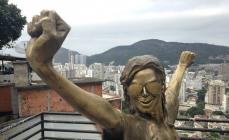In the seventeenth century, the seven-hundred-year period of great ancient Russian stone construction ended. Subsequently, it will fit into more than one fascinating page in the chronicle of world architecture. And already Russian architecture of the 18th century will become famous for a number of innovations in art and construction. These changes were mainly due to the weighty demands of the government. First of all, the architecture of the 18th century in Russia had to express all the power, strength and grandeur of a huge empire in the form of architectural structures.
With the political and economic development of Russia, new demands are placed on urban planning. Conventionally, all Russian architecture of the 18th century can be represented mainly by several architectural trends. This is primarily Baroque and Rococo, and, of course, classicism.

Russian architecture of the 18th century: main styles
According to the definition " baroque"is a unique direction in painting and art, the distinctive features of which are extraordinary splendor, a peculiar contrast, as well as a special combination of the real and the illusory. Recognized masters of the 18th century in the Baroque style were considered Trezzini, Schlüter, Michetti, Zemtsov, Rastrelli, Chevansky and Ukhtomsky. It was in their works that the architecture of the 18th century in Russia was most clearly expressed; their names will forever remain in the history of the great power.
The most significant contribution to the treasury of world and Russian architecture was the renovation of St. Petersburg. Among the variety of architectural structures of that time, the most impressive were: the Winter Palace, the Stroganov Palace, as well as the Smolny Monastery and Tsarskoye Selo. St. Petersburg could easily be called the cultural capital of that time. After all, it’s there Russian architecture of the 18th century was large-scale. Unlike Moscow and all other cities of Russia, the construction of religious buildings was practically not carried out in St. Petersburg - they were erected only in cases of extreme necessity.
Architecture in Russia of the 18th century, in particular in the second half, began to transform significantly. Decorative baroque and prim rococo were replaced by the architectural and artistic style - classicism. It quickly established itself not only in St. Petersburg and Moscow, but also spread throughout the country.
Classicism in Russia
Classicism(in translation from Latin - exemplary) - an artistic style created by a laconic combination of forms, samples and compositions of the art of the ancient world and a masterpiece of the Italian Renaissance.
The architecture of the 18th century in Russia was also formed in the capable hands of such famous founders of Russian classicism as: V. I. Bazhenov, A. F. Kokorinov, M. F. Kazakov, I. E. Starov. Talented architects erected beautiful monuments that contained both classical architectural principles and elements of world classics, and also clearly traced the traditions of Russian architectural heritage. The architectural structures of these architects are distinguished by their characteristic simplicity and rigor, as well as rationality.

18th century architecture in Russia became famous for the following creations of the architecture of early Russian classicism: St. Petersburg Academy of Arts, works by V. I. Bazhenov in Moscow - Pashkov's built house and the unrealized project of the majestic Kremlin Palace in Tsaritsyn; Golitsyn Hospital, Moscow Senate in the Kremlin, and Tauride Palace in St. Petersburg I. E. Starova and others.
The progressive traditions of Russian architecture of the 18th century were of great importance for the practice of later architecture. Every year the architecture was transformed, but some features of Russian architecture developed over the coming centuries, maintaining traditions and sustainability until the 20th century.

The 18th century is considered important and significant in Russian architecture and urban planning. It is characterized by three directions - Baroque, Rococo and Classicism, which appeared successively over the course of the century. During this period, new cities appeared, objects were created that in our time are considered recognized historical and architectural monuments.
First third of the 18th century. Baroque
In the first third of the century, all architectural transformations were inextricably linked with the name of Peter the Great. During this period, Russian cities have undergone significant changes both in socio-economic terms and in architectural and planning terms. It was at this time that industry developed, which led to the construction of many industrial cities and towns. The political situation in the country and abroad created the preconditions for the dominant nobility and merchants during this period to be drawn into the construction of public facilities. If before this period, the most majestic and beautiful were created mainly by churches and royal residences (chambers), then at the beginning of the 18th century in cities great importance was paid to the appearance of ordinary residential buildings, as well as the emerging theaters, embankments, there was a massive construction of town halls, schools, hospitals (the so-called gospitals), homes for orphans. Since 1710, brick has been actively used in construction instead of wooden buildings. True, initially this innovation concerned, first of all, the capitals, while for the periphery stone and brick remained prohibited for a long time.
Peter I creates a special commission, which in the future will become the main body of state planning for both the capital and other cities. Civil construction already prevails over church construction. Great importance is attached not only to facades, but also to the appearance of the entire city - houses are beginning to be built with facades along the streets, buildings are being deconsolidated for fire safety purposes, streets are being landscaped, roads are being paved, the issue of street lighting is being resolved, trees are being planted along the roadsides. In all this one can feel the visible influence of the West and the firm hand of Peter, who with his decrees practically brought about a revolution in urban planning in those years. Therefore, it is not surprising that Russia in a short period of time manages to practically catch up with Europe, reaching a decent level in terms of urban planning and urban improvement.
The main architectural event of the beginning of the century is considered to be the construction of St. Petersburg. It is from this city and the Moscow Lefortovo Sloboda that serious changes in the architectural appearance of other cities begin. Western-oriented Peter the Great invites foreign architects and sends Russian specialists to study in Europe.
Trezzini, Leblon, Michetti, Schedel, Rastrelli (father) and other eminent architects who were destined to make a great contribution to Russian architecture in the first quarter of the 18th century came to Russia. What’s interesting is that if at the beginning of their creative career in Russia they clearly followed their principles and Western architectural thinking, then after a certain period of time, historians note the influence of our culture and identity, which can be seen in their later works.
In the first third of the 18th century, the predominant direction in architecture and construction was Baroque. This direction is characterized by a combination of reality and illusion, splendor and contrast. The construction of St. Petersburg begins with the foundation of the Peter and Paul Fortress in 1703 and the Admiralty in 1704. Peter set serious tasks for the architects of that period in terms of compliance of the new city with advanced European principles of urban planning. Thanks to the coordinated work of Russian architects and their foreign colleagues, the northern capital acquired formally Western features in merging with traditionally Russian ones. The style in which numerous pompous palaces, churches, government institutions, museums and theaters were created is now often called Russian Baroque or Baroque of the Peter the Great era.

During this period, the Peter and Paul Cathedral, the summer palace of Peter the Great, the Kunstkamera, the Menshiikov Palace, and the building of the Twelve Colleges in St. Petersburg were created. The ensembles of the Winter Palace, Tsarskoe Selo, Peterhof, Smolny Monastery, and the Stroganov Palace are decorated in the Baroque style, created in this and later periods. In Moscow, these are the churches of the Archangel Gabriel and John the Warrior on Yakimanka; the main entrance to the Arsenal Courtyard of the Kremlin is decorated with characteristic elements characteristic of this period. Among the important objects of provincial cities, it is worth noting the Peter and Paul Cathedral in Kazan.
Mid 18th century. Baroque and Rococo
Despite the fact that the death of Peter I was a great loss for the state, it no longer had a significant impact on the development of urban planning and architecture of that period. Russian architects working in St. Petersburg under the supervision of foreigners adopted their experience, and those who were sent to study abroad also returned to their homeland. The country at that time had strong personnel. The leading Russian architects of that period were Eropkin, Usov, Korobov, Zemtsov, Michurin, Blank and others.
The style characteristic of this period is called Rococo and is a combination of Baroque and emerging classicism. It shows gallantry and confidence. Rococo is more typical for interior solutions of that time. In the construction of buildings, the pomp and pomp of Baroque is still noted, and the strict and simple features of classicism begin to appear.
This period, which coincided with the reign of Peter’s daughter Elizabeth, is marked by the work of Rastrelli the son. Brought up on Russian culture, in his works he demonstrated not only the brilliance and luxury of palace architecture, but also an understanding of the Russian character, Russian nature. His projects, together with the work of his contemporaries Kvasov, Chevakinsky, Ukhtomsky, organically fit into the history of Russian architecture of the 18th century. With the light hand of Rastrelli, domed compositions began to appear not only in the capital, but also in other Russian cities, gradually replacing spire-shaped ones. The pomp and scale of his palace ensembles have no analogues in Russian history. But with all the recognition and luxury, the art of Rastrelli and his contemporaries did not last long, and in the second half of the 18th century it was replaced by a wave of classicism. During this period, the most large-scale projects were created - a new master plan for St. Petersburg and a redevelopment project for Moscow.
Late 18th century. Classicism
 In Russian architecture in the last third of the 18th century, features of a new direction began to appear, which was later called Russian classicism. By the end of the century, classicism was firmly established as the main direction of art and architecture. This trend is characterized by the rigor of ancient forms, simplicity and rationality of designs. In contrast to the buildings in the Baroque style that filled St. Petersburg and its environs, classicism most manifested itself in the Moscow buildings of that time. Among many, it is worth noting the Pashkov house, the Senate building, the Tsaritsyn complex, the Golitsyn house, the Razumovsky palace, which are considered the most striking examples of classicism in architecture. In St. Petersburg at that time the Tauride Palace, the Alexander Nevsky Lavra, the Marble Palace, the Hermitage, the Hermitage Theater, and the Academy of Sciences were being built. Kazakov, Bazhenov, Ukhtomsky and many others are rightfully considered outstanding architects of that time.
In Russian architecture in the last third of the 18th century, features of a new direction began to appear, which was later called Russian classicism. By the end of the century, classicism was firmly established as the main direction of art and architecture. This trend is characterized by the rigor of ancient forms, simplicity and rationality of designs. In contrast to the buildings in the Baroque style that filled St. Petersburg and its environs, classicism most manifested itself in the Moscow buildings of that time. Among many, it is worth noting the Pashkov house, the Senate building, the Tsaritsyn complex, the Golitsyn house, the Razumovsky palace, which are considered the most striking examples of classicism in architecture. In St. Petersburg at that time the Tauride Palace, the Alexander Nevsky Lavra, the Marble Palace, the Hermitage, the Hermitage Theater, and the Academy of Sciences were being built. Kazakov, Bazhenov, Ukhtomsky and many others are rightfully considered outstanding architects of that time.
The period of the 18th century also included changes that affected many provincial cities of that time - Yaroslavl, Kostroma, Nizhny Novgorod, Arkhangelsk, Odoev Bogoroditsk, Oranienbaum, now Lomonosov, Tsarskoye Selo, now Pushkin and so on. Petrozavodsk, Taganrog, Yekaterinburg and many other cities began in the 18th century and became important industrial and economic centers of the Russian state during that period and subsequently.
Architecture of Russia of the 18th century (except Moscow), projects of residential and public buildings
The 18th century is very significant in Russian architecture. In it, three directions can be distinguished, which gradually replace each other, this and classicism. During this period of time, many new cities appeared, new buildings that are recognized as historical monuments and which can still be seen today.
Painting “View of St. Petersburg on the day of celebration of the city’s 100th anniversary” Benjamin Paterson. Canvas, oil. 66.5x100 cm. Sweden. Around 1803
The main construction takes place in St. Petersburg. This was connected with the start of the Northern War against Sweden, which began in order to liberate the Neva banks. Many military structures were built then, and the main one was the Peter and Paul Fortress. Closer to the south, facing the fortress, they built the Admiralty - a shipbuilding shipyard-fortress, not only engineers worked on their creation, but also Peter the Great himself. At first, settlements were built as peasant huts and city mansions, rarely painted to resemble bricks. To better understand what it looked like, you can look at the log house of Peter the Great on the Neva.

The Peter and Paul Cathedral was built in 1712-1733 (architect Domenico Trezzini) on the site of the wooden church of the same name (1703-1704)..

Wooden Peter and Paul Cathedral, antique carving
Although people were forced to move to St. Petersburg, construction still proceeded very slowly. Then the architects were given special tasks: the city had to become modern, and not only be architecturally designed, but also be comfortable in its layout.
The 18th century began with great transformations, the culprit of which was Peter the Great. During this time, socio-economic and architectural changes occurred in many Russian cities. At this time, industry began to actively develop, workers' settlements and public buildings appeared. Until this time, special attention was paid to churches and royal residences, but now more attention is paid to the appearance of ordinary buildings, theaters, embankments, schools and hospitals. They forgot about wood as a building material and replaced it with brick. To begin with, this material was used only in the capital, and in other cities of Russia neither brick nor stone was visible.
Peter the Great founded a special commission, which will now be involved in designing not only the capital, but also all major cities. Church construction is moving aside, leaving space for civil buildings. Now the main emphasis is not on the appearance of houses, but on the general appearance of the city, houses stretch along the streets with uniform facades, buildings are made less dense in order to protect against the danger of fires, for aesthetic purposes, street roads are equipped with lanterns, streets are landscaped. All this was clearly influenced by the west and Perth the First, which issued many decrees regarding urban planning, which reached the scale of revolution. In a short period of time, Russia has come close to Europe in terms of urban development.
The main event in the history of architecture is the construction of St. Petersburg. After this, other cities actively began to change, Peter the Great invited architects from the West, and Russian masters went to Europe for internships.
After some time, architects from a variety of schools gathered in the capital; new buildings combined Russian traditions, Italian, Dutch, French and so on. Also, the architecture of St. Petersburg becomes special thanks to the use of new building materials; the houses were either brick or mud hut, the plaster was used in two colors: red (brown) and white.
In 1710, by decree of Peter the Great, the development of the Gulf of Finland began, and famous palace and park ensembles appeared in Peterhof. In 1725, the two-story Nagorny Palace appeared, later it was rebuilt and expanded, the work was supervised by Rastrelli himself. At the same time, a small palace was built for Peter on the shore of the bay; it consisted of a state hall and several other rooms; it was the Monplaisir Palace.

Peterhof - view of the park from the palace, 1907, old postcard
Visitors Rastrelli, Schedel, Leblon, Trezzini and others promise to make a great contribution to architecture. It is worth noting that when they just started creating in Russia, they clearly followed their previous experience, creating according to the European analogue, but after some time, they were influenced by Russian culture and this greatly affected their work.
The first third of the 18th century was marked as the Baroque period. The buildings of this time were distinguished by a combination of the incongruous, contrast and pomp, reality and illusion. In 1703-1704 In St. Petersburg, construction began on the Peter and Paul Fortress and the Admiralty. Peter had high hopes for the architects and monitors the execution of the work very strictly. The resulting style with luxurious palaces, churches, museums and theaters was called Russian Baroque (Baroque of the Peter the Great).

Panoramic view of the Spit of Vasilyevsky Island in St. Petersburg, made by J. A. Atkinson in the period 1805-1807. Signature (English, French): "Sheet 4. Exchange and warehouse. New exchange. Fortress of St. Peter and St. Paul."
During this time, the Peter and Paul Palace, the Summer Palace, the Kunstkamera, the building of the Twelve Colleges, and the Menshikov Palace were built. A large number of churches appeared in Moscow, all of them were decorated with Baroque elements. The Peter and Paul Cathedral in Kazan became quite an important object at that time.
By the middle of the 18th century, Russia lost Peter the Great, this was a great loss for the state and for all people, but as for urban planning and architecture, there were no significant changes after his departure. The country had very strong masters, because many of them were trained abroad, the most famous and in demand at that time were Blank, Michurin, Usov, Zemtsov, etc. Buildings in the Rococo style began to appear, that is, combining Baroque and Classicism at the same time. Buildings become more confident and elegant. Rococo manifests itself not only in external details, but also in the interior. Outside, as well as inside, the buildings are pompous, but at the same time strict.
At this time, Elizabeth, the daughter of Peter, had just begun to rule, and she assigned a lot of work to Rastrelli the younger. He grew up in the conditions of Russian culture, and therefore his works noted brilliance and luxury along with the Russian character. Together with Kvasov, Chevakinsky and Ukhtomsky, they created monuments of Russian architecture. Rastrelli created dome compositions throughout Russia, and was not limited to Moscow or St. Petersburg; they increasingly replaced spire-shaped details. Russian history no longer remembers anything like such chic and bulky Russian ensembles. But, despite the large number of Rastrelli fans, his style quickly gave way to the next one - classicism. During this period, the plan of St. Petersburg completely changed and Moscow was redeveloped.
The last third of the 18th century was occupied by a new direction in architecture - Russian classicism. By the end of the century, classicism had become a stable movement in art. It is characterized by strict forms with antique elements, the absence of unnecessary details, luxury, and rational designs. Most of these buildings can be seen in Moscow, but this does not mean that they were not there in other cities. The most striking examples for Moscow were the Razumovsky Palace, the Golitsyn House, the Tsaritsyn Complex, the Senate building and the Pashkov House. In St. Petersburg, it is worth noting the Academy of Sciences, the Hermitage Theater, the Hermitage itself, the Marble Palace, the Tauride Palace. The most famous architects of that time were Ukhtomsky, Bazhenov and Kazakov.

The Marble Palace was built in 1768-1785 according to the design of the architect Antonio Rinaldi in the classicism style, commissioned by Empress Catherine for her favorite Count G. G. Orlov. The Marble Palace is the first building in St. Petersburg whose facades are lined with natural stone. Lithograph by Joseph Charlemagne (1782-1861)
Classicism is a style that develops by borrowing forms, patterns and compositions from the ancient world and the Italian Renaissance. Buildings appear with regular shapes and areas, logical, symmetrical, rational, there is rigor and harmony in everything, the order tectonic system is actively used. Many customers could not afford any more Baroque houses, now came the period of peasants and merchants with less economic opportunity.
Thanks to the economic and social situation in the country, domestic and foreign markets began to actively develop, allowing for the expansion of industrial and handicraft industries. There was a need for government and private buildings: chambers of commerce, guest houses, markets, fairs, warehouses. Unique buildings for that period also appeared: banks and exchanges.
Public buildings began to appear in all cities: schools, gymnasiums, institutes, hospitals, prisons, barracks, boarding houses and libraries. The cities grew rapidly, so there was no more funding for Baroque houses and there were not enough craftsmen for this.
In 1762, a commission was founded on issues of stone construction in St. Petersburg and Moscow. It was created to regulate and supervise urban planning. The commission existed until 1796, it included Kvasov, Starov, Lem and other great architects. The main factors were land and water highways, borders between cities, trading floors and administrative buildings. The city had a clear rectangular layout. The height of the streets had clear restrictions, there were patterns that had to be followed, and houses had to be located at a minimum distance from each other. Architectural solutions were enlivened by figured window frames.
In the provincial cities of Russia, buildings were not built higher than 1-2 floors, while in St. Petersburg one could see 3- and 4-story buildings. Kvasov developed a project according to which the territory of the Fontanka embankment was improved; it soon turned into an arc-forming highway.
The most striking example of classicism can be called “Pleasure Houses” in Oranienbaum; now it no longer exists, so it can only be seen on the pages of books and textbooks. Kokorin worked on this building, and Vista at that time built the Botny House in the Peter and Paul Fortress.
As for provincial cities, the art of the 18th century left its mark most on Tsarskoye Selo, Yaroslavl, Kostroma, Nizhny Novgorod, Arkhangelsk, Odoev Bogoroditsky, etc. After this period, Petrozavodsk, Yekaterinburg, Taganrog, etc. began to actively develop, they are large attention was paid to industry and the economy of the entire state.


On this topic:
“Architecture of Russia in the 18th century” - “Tsentrnauchfilm” (00:26:26 color) Director - A. Tsineman
Russian architecture still has a long way to go. Let's go back to the roots - the first Russian architects, who by their example proved that Russian architecture existed, exists and, hopefully, will exist in the future. After all, the Russian expanses are a huge field for activity.
Fyodor Kon (1540-1606)
Smolensk Fortress. Tower. XVI-XVII centuries
In fact, the first Russian architect-builder of fortresses. Being the son of a peasant, he fled to Europe, where he received an excellent private education. Then he worked in France, Belgium, Denmark, Poland, Italy, where he established himself as an excellent craftsman. Fyodor, who returned to Rus', was naturally put in prison, but was soon released and allowed to create. For a couple of years he built shops and sheds, and then suddenly received an order to build the walls of the White City in Moscow. And then off we went - the walls of the Boldinsky, Pafnutyevo-Borovsky and Simonov monasteries, as well as the pearl of Russian architecture - the Smolensk Kremlin. The main “trick” of the Horse was the combination of convenience, strength and beauty - so he decorated purely defensive towers with kokoshniks and patterns.
And yes, the nickname Horse perfectly characterized Fedor: he was tall, strong and hardworking.
Dmitry Ukhtomsky (1719-1774)
Bell tower of the Trinity-Sergius Lavra, 1741 – 1768
An incredibly prolific representative of the Rurikovich family, Ukhtomsky is considered one of the most brilliant Russian architects who worked in the Elizabethan Baroque style. A boy from an impoverished princely family was sent to Moscow, where he quickly mastered engineering and art history. Starting with a little practice, he soon built triumphal arches (including the famous Red Gate) and pavilions in honor of the coronation of Elizabeth Petrovna. For her and, according to rumors, her favorite Stepan Apraksin, the famous dresser house on Pokrovka, considered one of the most interesting buildings in the capital, was built. Ukhtomsky owns the design of the tallest bell tower in Russia, built in the Trinity-Sergius Lavra.
In 1745 he became the chief architect of Moscow and led his own “team”. The prince also developed the first general plan of Moscow, restored the Kremlin and opened the country's first architectural school.
Vasily Bazhenov (1737-1799)
Pashkov's house. 1784 - 1786
Relatively little is known about one of the most famous Russian architects, and the authorship of most of his projects is not documented. As a boy, Bazhenov was noticed by the famous architect Ukhtomsky at whose school he studied. Then traditional practice in Europe and a triumphant return home. Being a narcissistic perfectionist, he often did not see eye to eye with the powers that be. Thus, having received orders for the reconstruction of the Kremlin and the construction of the Tsaritsyno royal residence, he never completed these projects, and due to a conflict with Catherine II, he was even dismissed from service. Not many of Bazhenov’s buildings have reached us, but each of them is a true masterpiece: the Pashkov House and the Great Tsaritsyn Bridge in Moscow, the Mikhailovsky Palace in St. Petersburg, etc.
Petrovsky Travel Palace, 1776-1780s. An example of Russian neo-Gothic architecture.
The buildings of the most famous Russian architect are scattered throughout almost the entire historical part of Moscow. From the Senate in the Kremlin to the Petrovsky Travel Palace in the Dynamo metro area. As a student of Bazhenov, Matvey Kazakov adopted his teacher’s love of pseudo-Gothic, but most of all he gravitated towards strict symmetry and classicism. Combining both ideas into one, he rebuilt Tsaritsyno and erected dozens of unique buildings in completely opposite styles. And this despite the fact that the architect never left Russia and could only admire the masterpieces of European architects from pictures. Many of the architect’s buildings have not survived to this day, but Matvey Fedorovich’s style once determined the appearance of the so-called “Cossack Moscow.”
The prominent architect met his death in Ryazan in 1812. Upon learning that the fire had destroyed his beloved city, Kazakov became ill and died.
Osip Bove (1784-1834)
Moscow triumphal gates, 1829 – 1834. in honor of the victory of the Russian people in the Patriotic War of 1812.
The first “non-Russian” architect on our list is an architect. However, in spirit Osip, born Giuseppe, was a worthy son of Russia. Born into the family of a Neapolitan artist, he became involved in art early. During World War II, he participated in the Moscow militia, and after the fire, Beauvais was assigned to restore the central part of the city northwest of the Kremlin. Not surprisingly, the authorities soon noticed his talent and entrusted the Italian with “facade work” to restore the Mother See. It was thanks to him that Moscow acquired the appearance of a European city with colonnades of mansions in the classicist style, squares, monuments and public gardens. His best projects include the First City Hospital complex, Manege and Alexander Garden.
Fyodor Shekhtel (1859-1926)
The most famous monument of Moscow Art Nouveau, built in 1902 for millionaire Sergei Ryabushinsky.
Muscovites owe the best examples of Moscow modernism to this man. German by birth, Franz Albert converted to Orthodoxy at the age of ten and literally fell in love with Russian culture. No wonder it was he who built houses for prominent Old Believers who loved comfort combined with traditional ornaments and motifs. Shekhtel worked out the smallest details in his projects - from dozens of options for latches, to flights of stairs and the location of mirrors. Often he was invited to design ready-made buildings. His best Moscow projects include the Ryabushinsky and Morozov mansions, the Yaroslavsky railway station, the Moscow Art Theater building. Chekhova and others.
Alexey Shchusev (1873-1949)
Church of the Intercession of the Marfo-Mariinsky Monastery. 1908 - 1912
The most “convenient” Russian architect of the turn of the 19th-20th centuries. His heritage includes chapels and temples, as well as the NKVD building on Lubyanka and the Komsomolskaya-Koltsevaya metro station. Alexey Shchusev was never afraid to experiment with styles - while his colleagues were guided by French Art Nouveau, he created his own style, gravitating towards the architecture of Novgorod Rus' (for example, the Marfo-Mariinsky Convent on Bolshaya Ordynka in Moscow).
Even before the revolution, Shchusev received an order for the construction of the Kazan station - a kind of tower with turrets. The architect was also in demand among the “Soviets” - the project of Lenin’s mausoleum forever immortalized his name and protected him from repression. Following the architectural fashion, Shchusev entered constructivism and then the Stalinist Empire style, invariably winning design competitions. Thanks to him, many Moscow buildings and churches were preserved and restored.






